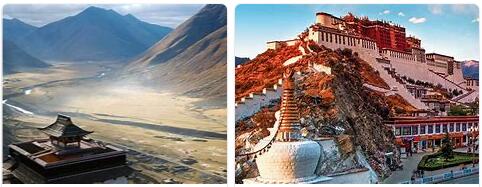Tibet Tourist Information

Going on the road, you should have a package with documents (voucher, insurance policy, air ticket) and a passport, for the validity of which you are responsible yourself. We remind you that you need to be at the airport two hours before departure in order to have time to fill out a declaration and go through customs control.
Location. Tibet Autonomous Region of China is located in the southwestern region of China. Geographically, Tibet is the entire Tibetan Plateau, bounded from the south by the Himalayas, and from the north by the Kun-lun ranges. The area of the Tibetan plateau is almost equal to Western Europe. The average height above sea level on the Tibetan Plateau is about 4 thousand meters.
Capital. The administrative center is Lhasa, the center of the Tibet Autonomous Region and the center of the historical region. The city is located at an altitude of 3.680 m in the valley of the Kyi-Chu River, a tributary of the Brahmaputra.
Language. The official language is Chinese and Tibetan.
Visa. To visit Tibet, you can come from Nepal, the travel company will issue you a visa to Tibet in CTTB (China Tibet Tourism Bureau). Or visit from other regions of China, for this you need to have a valid Chinese visa and permission to visit Tibet, which is issued at the TTB (Tibet Tourism Bureau) through a travel agency.
Features of customs control. Valuables (photo and movie cameras, radios, watches, jewelry) must be indicated in the customs declaration and are subject to mandatory re-export. Duty-free import allowed: 2 bottles of alcohol, 2 packs of cigarettes, 900 m of film 8 mm wide, 72 film cassettes. All exported antiques must be properly certified; otherwise they may be confiscated.
Time. Local time – + 6 from Kiev (+5 in summer)
Climate. The climate of Tibet is characterized by extreme temperature changes and low humidity.
Best time to visit Tibet: spring, summer, autumn.
Religion. Lamaist Buddhism.
Kitchen. In all hotels that accept foreign tourists, there are restaurants of Tibetan, Chinese and European cuisine.
Hotels. Tibet is an extremely backward region, and especially the budget category hotels have the most minimal amenities. Guesthouses along the way (Nyalam, Tingri) are essentially inns with a shared toilet and water in the well. The hotels in Gyantse, Shigatse and Lhasa are slightly better, but don’t expect too much. Such is Tibet as a whole and this is its exoticism, which tourists come to see.
Transport. In cities, vehicles: buses, taxis, bicycle taxis, bicycles (you can rent in hotels). Between cities, there are regular buses. In addition, you can rent a jeep (approximately 4.5 Yuan/km and 400 Yuan per idle day).
The most common mode of transportation in Tibet is jeeps.
In the cities there are cycle rickshaws and taxis. Large groups of tourists travel on custom buses adapted to difficult off-road conditions. Regular buses run between Lhasa and the airport, Tsetang, Shigatse and Gyantse. They drive irregularly, and there is no need to talk about the schedule and comfort. In Lhasa, you can also find buses and jeeps looking for fellow travelers. It is much cheaper, but the road is only guaranteed one way and provided you have the necessary permits to visit the area, written in Chinese and with a red Chinese seal. Asphalt highways are laid only in cities. The road from Lhasa to Shigatse is considered to be a new good road; plowed by all-terrain vehicles and crossed by river floods. It can bring some trouble to travelers.
Currency. In Tibet, banks accept all major foreign currencies and checks in exchange for yuan. The current ratio is 1 US dollar = 8 Chinese yuan. Credit cards are not accepted.
Tips. Tipping is accepted but not required. The restaurant will always bring you change. If you liked the food and service, when paying the bill, give the waiter a sign that no change is needed. The same is true for taxis.
Currency exchange. There are currency exchange points in all large hotels, and in all banks.
Holidays and non-working days.
New Year (Lozar): occurs in February and lasts three days, preceded by a day of masquerade dances (cham). Great Prayer Festival (Monlam Tchenmo): unfolds over the next 22 days. On the days preceding the holiday, large ritual pies are baked, which are then distributed to the population. SAKADAWA: May’s full moon festival of the fourth month. This holiday is celebrated by all Buddhist schools without exception. It denotes the awakening and departure into Parinirvana (death) of the Buddha. Operas are improvised in Lhasa under the open sky, and the whole city is lit up with lights.
Shops, markets: Barkhor market (Lhasa) – in the center of the old city, located around the Jokhang hill. There, according to tradition, everyone moves in the same direction, like on a skating rink. Religious and secular items of various origins are sold. Bargaining is common everywhere.
Phones.
How to call Kyiv: 0038 – 044 – subscriber number